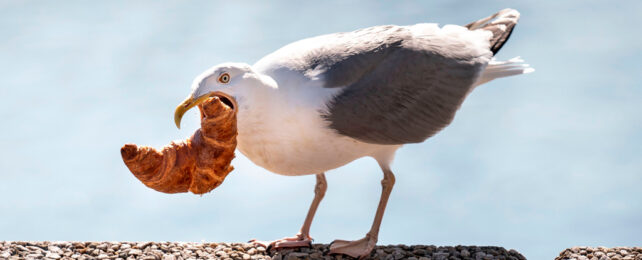Ask anyone living in a coastal area of the UK and they'll confirm that seagulls can be a nuisance. These birds' pilfering of food knows no bounds, and no one is safe from one of their thieving attacks.
For many people, this behavior is the result of the gulls' inherent aggression. But in reality, gulls such as the herring gull are more intelligent than we give them credit for, particularly in terms of their social skills.
These birds are able to pay attention to the behavior of others and use the information they gather to inform their own foraging choices.
Herring gulls thrive in modern urban areas. Urban gull colonies have taken off since making European cities their home in the mid-20th century, despite the general decline in gulls' overall population.
As a species, they have also shown great flexibility in their diet, nesting, and reproductive behavior.
As a scientist interested in animal cognition, I'm fascinated by the intelligent behavior that allows gulls to successfully forage human foods.
Research has already shown that urban herring gulls adapt their foraging behavior to human activity patterns, increase their attention towards a person in possession of food, and that they prefer food that has been touched by a person compared to food that has not.
To build on this, my masters students Franziska Feist and Kiera Smith and I set out to discover if the birds could not only track objects handled by humans but if they could also compare objects in their environment with those being manipulated by a person.
The ability to compare objects and identify whether they are identical implies a higher cognitive ability than object tracking alone.
Quick learners
We placed two Walkers brand crisp packets of different colors on the ground a few meters in front of single or small groups of herring gulls on Brighton beach.
We sat on the sand and held a third crisp packet that matched the color of either one of the packets on the ground.
We then recorded the gulls' response to see if, as hypothesized, they would choose the crisp packet that matched the color of the one in our hand.
Of the gulls that pecked at the crisp packets, nearly all (95 percent) did so to the crisp packet that color-matched the one we were holding. This suggests that these gulls possess the ability to identify and compare objects within their surroundings.
In addition, the gulls' seemed to observe the foraging choices of others – specifically people in this case – and use the information they obtained to decide what to eat.
The number of approaches towards us did not differ significantly between adults and young birds (meaning, any with brown plumage).
However, the majority that made an attempt at stealing one of the crisp packets were adults.
Around 86 percent of the recorded pecks came from adults, despite these birds making up just 46 percent of our entire sample.
This suggests that stealing food requires a certain level of boldness and skill that most young birds lack.
Another plausible explanation is that the young birds may have been deterred by the competition with adult birds, which they are likely to lose.
Wide behavioral repertoire
Our findings are interesting because herring gulls have not evolved with humans. In fact, their urbanization only began relatively recently – around 80 years ago.
That means this behavior cannot have come from an innate ability resulting from co-evolution or an extended period of living alongside humans. Rather, it must be the result of a broader, more general behavioral repertoire.
From a scientific perspective, this is fascinating. It seems that herring gulls are an intelligent and versatile predator that has successfully adapted to urban environments due to their observational skills and behavioral flexibility.
Yet, for many people, this may have some rather negative implications. Coastal residents and visitors frequently experience the impressive yet annoying ability of these birds to observe, target, and steal food from picnics, bins, and people directly.
We suggest that these problems likely stem from more than people feeding urban gulls directly.
It seems that simply watching us eat something will make that specific food item, and any identical items in the vicinity, more attractive to these birds.
It is this cognitive toolkit that will make tension between humans and urban herring gulls difficult to manage.
Our work does, however, agree with existing studies that suggest only around a quarter of the UK urban gull population will actually attempt to steal food from a person. Less than a fifth of the gulls we sampled approached the crisp packets when we were sitting nearby.
Regardless, any attempt to minimize conflict should extend beyond deterring people from feeding gulls and should take into account these birds' exceptional observational skills.
What is clear, though, is that we can't rely solely on signs insisting that people "do not feed the birds".![]()
Paul Graham, Professor of Neuroethology, University of Sussex
This article is republished from The Conversation under a Creative Commons license. Read the original article.
